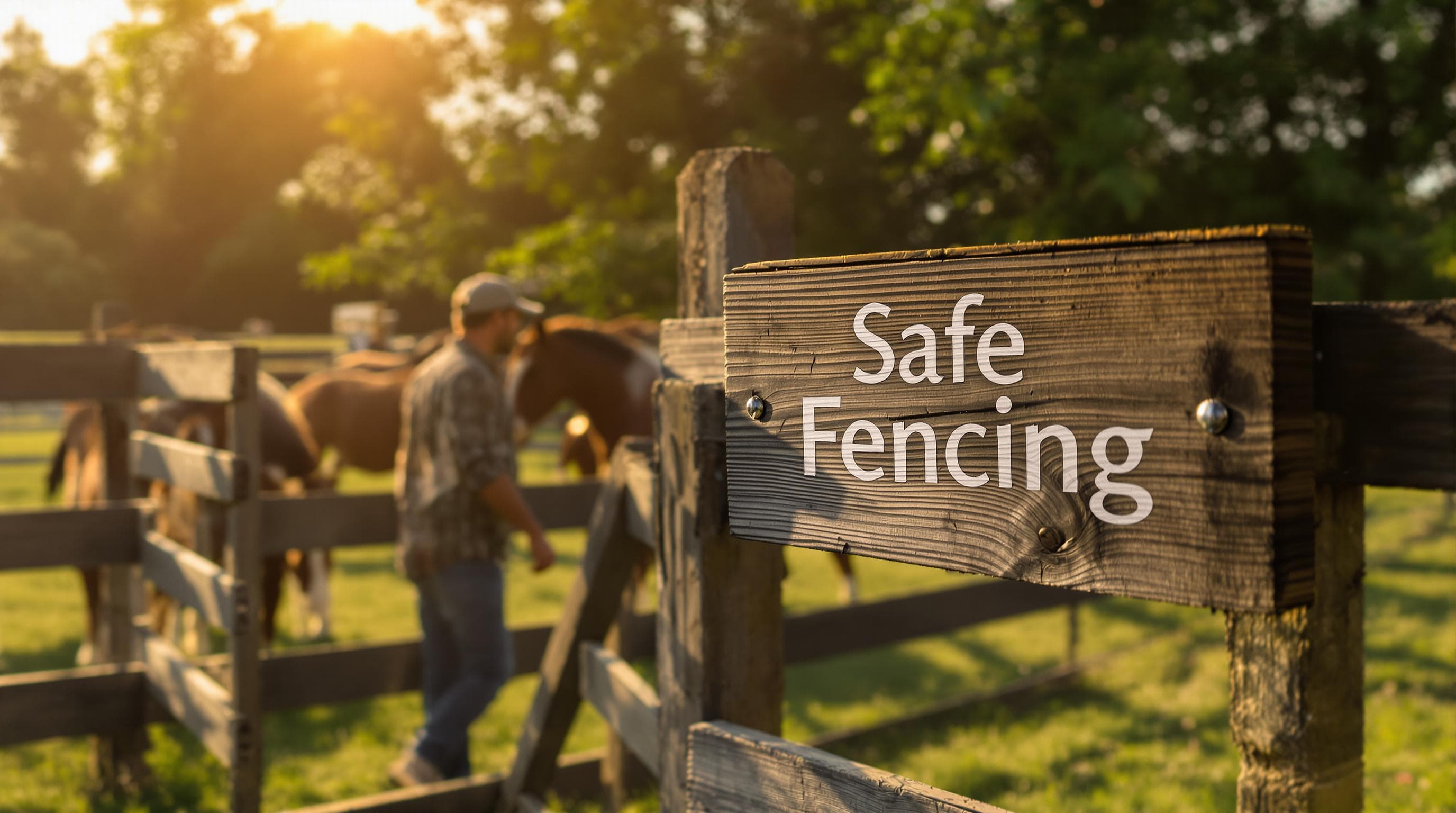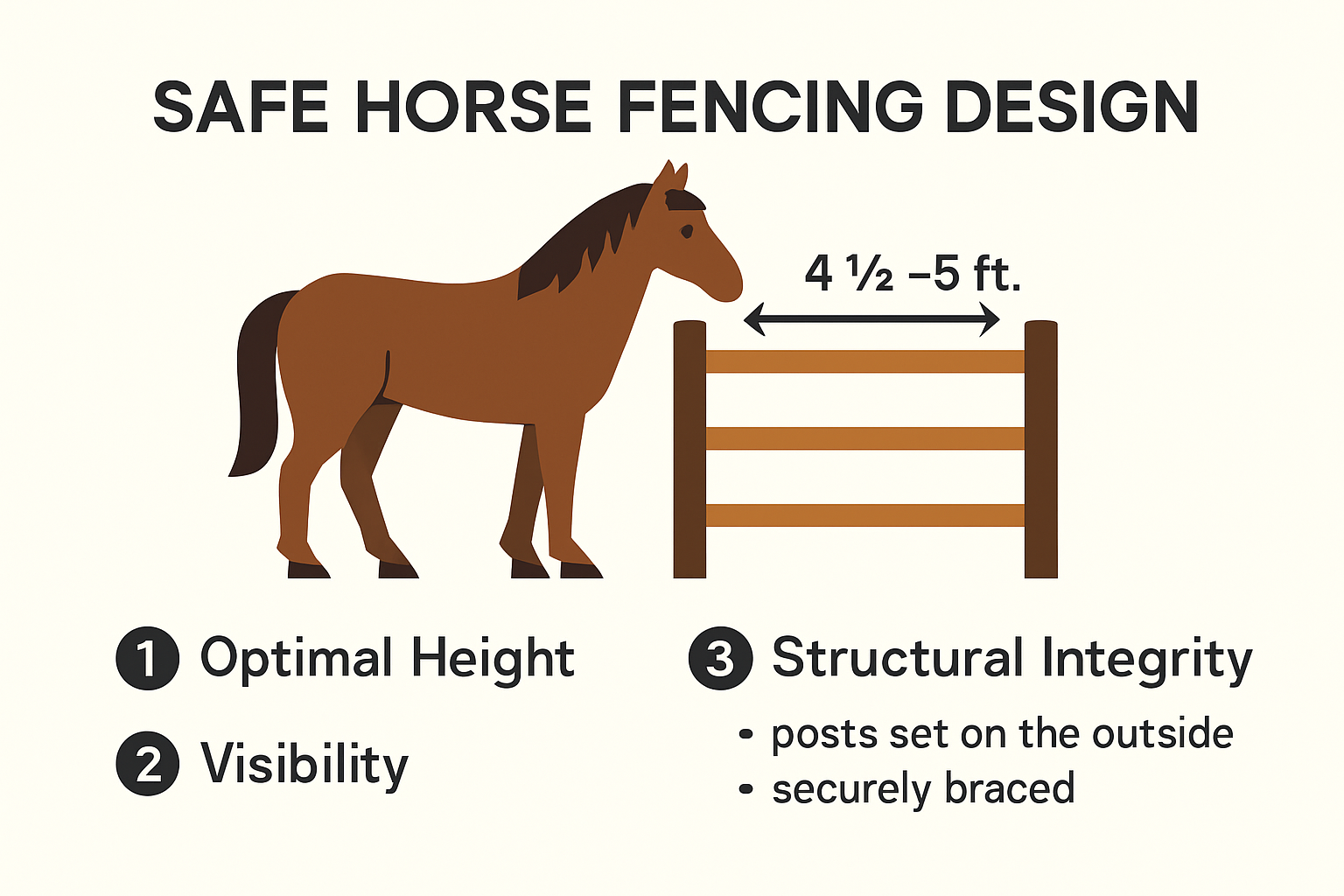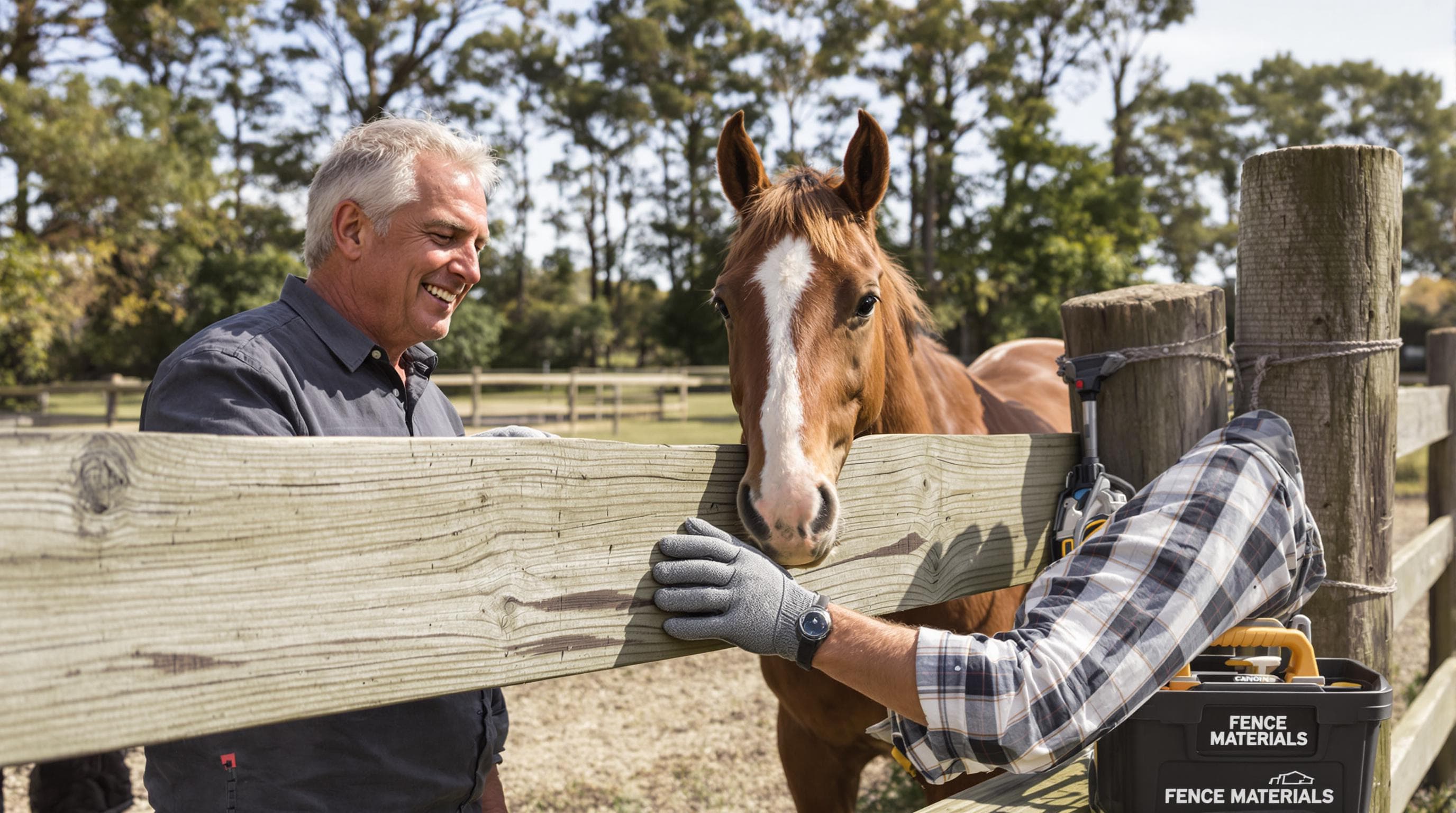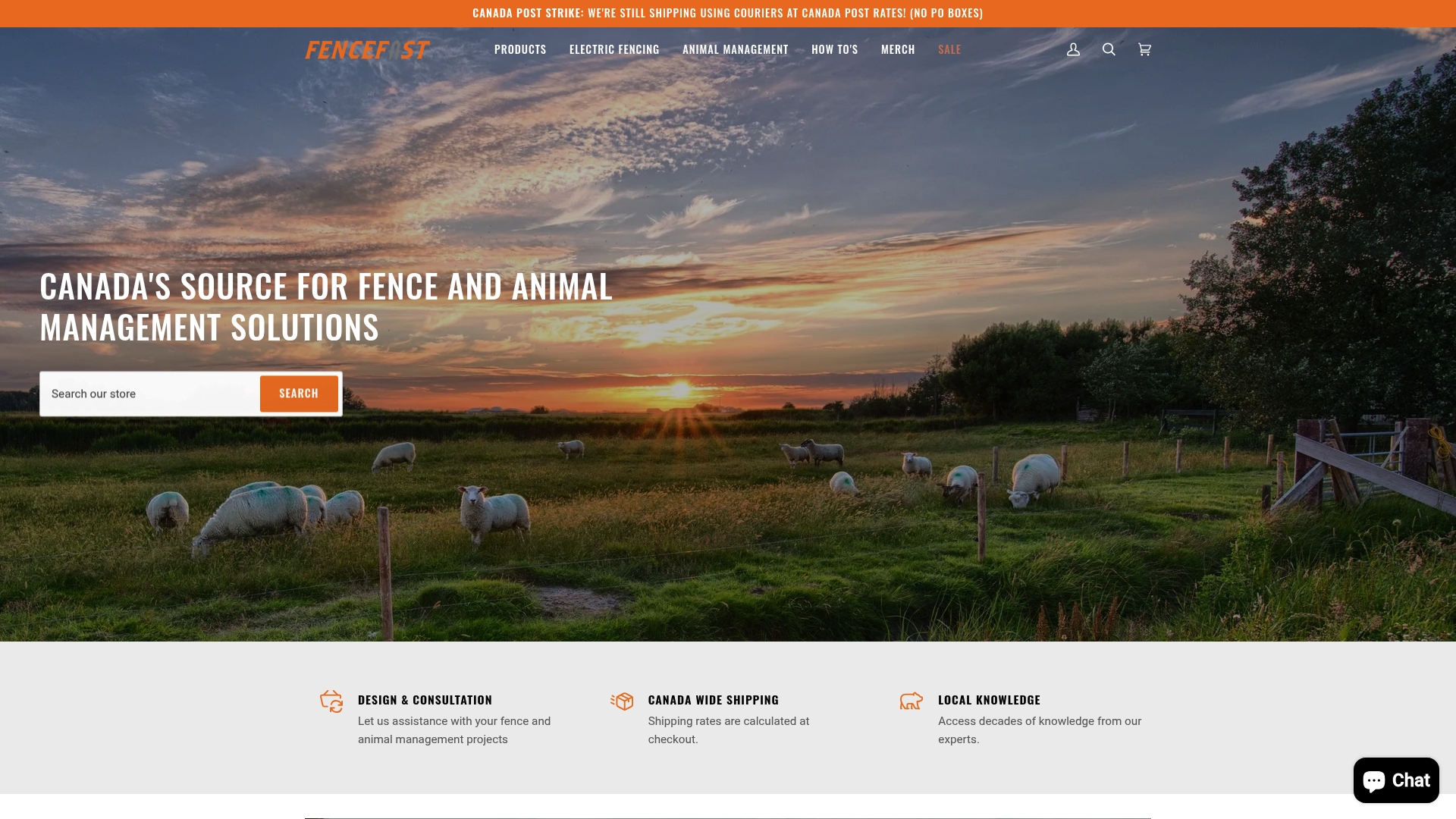
Horse fencing safety is a massive concern for every owner and for good reason. Horses can run up to 40 miles per hour yet more than 30 percent of horse injuries happen because of unsafe fencing. Most people focus on how tall a fence is or how tough the boards feel. Shockingly, it is often the small stuff like poor visibility and weak post placement that trip up even experienced barns.
Table of Contents
- Key Factors For Safe Fencing Design
- Top Safe Fencing Materials For Horses
- Essential Installation And Maintenance Tips
- How To Choose The Right Fence For Your Needs
Quick Summary
| Takeaway | Explanation |
|---|---|
| Prioritize Visibility and Strength | Horse fencing should be highly visible and robust enough to withstand the impact of a running horse, with a recommended height between 4.5 to 5 feet for effective containment. |
| Choose Appropriate Materials | Select fencing materials such as durable wood, high-tensile wire, or modern composite options based on their safety, visibility, and maintenance needs. Each material has unique benefits and requires careful consideration. |
| Implement Strategic Installation and Maintenance | Proper installation techniques and regular maintenance checks are crucial for safety, including post placement, spacing, and seasonal care to mitigate environmental impacts and prevent injuries. |
| Assess Property and Horse Needs | Evaluate the layout of pastures, the requirements of the horse population, and consider budgeting for initial costs, ongoing maintenance, and expected lifespan to make informed fencing decisions. |
Key Factors for Safe Fencing Design
Designing safe fencing for horses requires careful consideration of multiple critical elements that protect both the animals and the surrounding environment. The right fence design goes far beyond simply creating a boundary line. It involves understanding horse behavior, material characteristics, and potential safety risks that could compromise animal welfare.
Visibility and Structural Integrity
Horse fencing must prioritize visibility and strength. According to Extension Horses, an ideal horse fence should be highly visible, solid enough to withstand a running horse’s impact, yet flexible to prevent potential injuries. The recommended fence height ranges between 4.5 to 5 feet, providing adequate containment while minimizing escape risks.
The U.S. Forest Service provides specific guidance on fence construction. Their Equestrian Design Guidebook recommends using corner posts with larger diameters to withstand additional stress. These posts provide crucial structural support, ensuring the fence remains stable under various environmental conditions and horse interactions.

Material Selection and Safety Considerations
Choosing the right materials is paramount in creating safe horse fencing. Different materials offer unique advantages and potential drawbacks. Wooden rails provide a traditional aesthetic and natural appearance but require regular maintenance to prevent splintering or rotting. Wire mesh can offer visibility and durability but must be carefully installed to prevent potential entanglement.
Electric fencing presents another option, serving as both a physical and psychological barrier. When properly installed, electric fences can effectively discourage horses from testing boundaries while minimizing direct contact risks. However, careful calibration of voltage and consistent maintenance are essential to ensure animal safety.
Comprehensive Safety Design Principles
Safe horse fencing transcends basic containment. The bottom rail or strand should be positioned at least 1 foot above ground level, allowing for easier maintenance and preventing smaller animals from accessing the enclosure. Smooth edges, absence of protruding elements, and regular inspection are critical components of a comprehensive safety strategy.
Consider the specific needs of your horse population. Young, energetic horses might require different fencing approaches compared to older or more settled animals. Factors like pasture layout, terrain, and local weather conditions will also influence your fencing design decisions.
Ultimately, safe horse fencing is an investment in animal welfare. By prioritizing visibility, structural integrity, appropriate materials, and thoughtful design, horse owners can create environments that protect their animals while providing them with the freedom to move and explore safely.
Top Safe Fencing Materials for Horses
Selecting the right fencing material is crucial for ensuring horse safety, durability, and long-term performance. Different materials offer unique advantages and challenges, requiring horse owners to carefully evaluate their specific needs, environment, and budget.
Wood Fencing: Traditional Strength and Visibility
Extension experts recommend wood as a popular fencing option due to its natural strength and excellent visibility. Certain wood species provide superior durability and resistance to decay. Pressure-treated or naturally decay-resistant woods like cypress, black locust, and red cedar stand out as top choices for horse enclosures.
Wooden fences offer a classic aesthetic and substantial impact resistance. However, they demand consistent maintenance. Regular painting, staining, and inspection are essential to prevent splintering, rotting, and potential injury risks. Owners must carefully smooth rough edges and replace damaged boards promptly to maintain safety standards.

High-Tensile Wire and Steel Options
High-tensile wire fencing presents a cost-effective alternative for horse enclosures. While economical, this material requires strategic implementation. Adding visibility features like top rails or flagging helps horses recognize and respect boundary lines. Electric components can further enhance boundary enforcement.
Steel pipe fencing offers remarkable durability and low maintenance. Galvanized steel prevents rust, and appropriate protective coatings extend its lifespan. However, its rigidity poses potential risks during horse collisions. Owners must carefully consider the fence’s ability to absorb impact and potentially supplement with more flexible elements.
Composite and Modern Fencing Solutions
Modern fencing technologies introduce innovative materials designed specifically for horse safety. Synthetic materials like polymer and composite fencing provide lightweight, durable alternatives to traditional options. These materials resist weathering, require minimal maintenance, and can be engineered to provide optimal visibility and flexibility.
Electric fencing systems offer another sophisticated solution. When professionally installed, electric fences create both physical and psychological barriers. They discourage horses from testing boundaries while minimizing direct contact risks. Careful voltage calibration and consistent maintenance ensure safe and effective operation.
Choosing the right fencing material involves balancing multiple factors: safety, durability, maintenance requirements, initial cost, and environmental conditions. Horse owners should conduct thorough research, consult local agricultural experts, and consider their specific property characteristics before making a final decision.
Below is a comparison table summarizing the main features, advantages, and considerations for the top horse fencing materials discussed above.
| Fencing Material | Key Features | Advantages | Considerations |
|---|---|---|---|
| Wood | Traditional, high visibility, strong | Aesthetic, impact resistance | Requires regular maintenance, may splinter or rot |
| High-Tensile Wire | Economical, can add visibility aids | Cost-effective, durable | Needs visibility, risk of entanglement if not installed properly |
| Steel Pipe | Very durable, low maintenance | Rust-resistant, long lifespan | Rigid, can be hazardous on impact |
| Composite/Synthetic | Weather-resistant, highly visible | Low maintenance, flexible | Higher upfront cost |
| Electric Fencing | Both physical/psychological barrier | Deters testing, flexible | Requires regular checks and voltage calibration |
Essential Installation and Maintenance Tips
Proper horse fence installation and ongoing maintenance are critical components of ensuring animal safety and enclosure longevity. A well-designed and meticulously maintained fence protects horses from potential injuries while providing secure boundaries for their environment.
Strategic Installation Techniques
The University of Minnesota Extension recommends creating highly visible fences at least 5 feet tall for perimeter containment. Professional installation begins with precise post placement and proper ground preparation. Corner and gate posts require deeper installation and larger diameters to withstand additional structural stress.
Professional spacing between posts is crucial. Typically, posts should be placed 8 to 12 feet apart, depending on the fencing material and terrain. Ensuring posts are level, firmly anchored, and aligned creates a stable foundation that prevents sagging and maintains fence integrity over time.
Regular Inspection and Maintenance Protocols
According to the British Horse Society, daily visual inspections are essential for fence safety. Owners should systematically check for potential hazards like loose wires, broken boards, protruding nails, or signs of wear that could compromise horse safety.
Rutgers New Jersey Agricultural Experiment Station emphasizes immediate repair of any fence damage. Small issues can quickly escalate into significant safety risks. Replacement of damaged sections, tightening of loose components, and addressing potential weak points should occur promptly to maintain a secure enclosure.
The following checklist table highlights essential horse fence maintenance tasks and suggested inspection frequency based on recommendations from the article.
| Maintenance Task | Frequency |
|---|---|
| Visual inspection for hazards | Daily |
| Tighten/repair loose elements | As needed |
| Replace damaged boards/wire | Immediately |
| Clear vegetation along fence | Monthly |
| Check post stability | Seasonally |
| Apply protective coatings | As recommended |
Seasonal Maintenance and Long-Term Care
Different seasons present unique challenges for horse fencing. Winter conditions can cause ground shifts, potentially compromising post stability. Summer heat might cause wood to warp or metal to expand. Implementing seasonal maintenance routines helps mitigate these environmental impacts.
Regular maintenance also involves cleaning fence lines, removing vegetation that might compromise structural integrity, and checking for signs of rust, rot, or material degradation. Applying protective coatings, such as rust-resistant paint for metal fences or sealants for wooden structures, extends their lifespan and maintains their protective capabilities.
Ultimately, horse fence maintenance is an ongoing commitment. Investing time in careful installation and consistent upkeep prevents potential injuries, reduces long-term repair costs, and creates a safe, secure environment for horses. Owners who approach fence maintenance as a critical aspect of horse care demonstrate a profound commitment to animal welfare and responsible horse management.
How to Choose the Right Fence for Your Needs
Selecting the ideal horse fence requires careful evaluation of multiple factors beyond simple boundary creation. Horse owners must consider safety, functionality, budget, and long-term performance when designing their equine enclosures.
Assessing Property and Horse Requirements
Extension experts recommend strategic pasture and paddock design that centers around barn locations and considers potential future expansions. The layout should accommodate equipment access and provide flexibility for multiple horses. Gate placement becomes critical, with corner positioning offering optimal functionality and ease of management.
Each horse population presents unique challenges. Young, energetic horses might require different fencing approaches compared to older or more settled animals. Consider factors like horse temperament, herd dynamics, and individual behavioral patterns when selecting fence design and materials.
Budgeting and Cost Considerations
According to horse fencing specialists, comprehensive budgeting extends beyond initial material costs. Owners must factor in long-term maintenance expenses, potential repair frequency, and material durability. Some fencing options might have higher upfront investments but lower ongoing maintenance costs, while others present more economical initial purchases with increased future upkeep requirements.
A thorough cost analysis should include:
- Material expenses: Initial purchase price of fencing components
- Installation costs: Professional setup or potential DIY investments
- Maintenance requirements: Annual upkeep, painting, repairs
- Replacement frequency: Expected lifespan of chosen materials
Safety and Functional Design Principles
Comprehensive fencing guides emphasize that horse fencing transcends mere containment. The ideal fence must be highly visible, flexible enough to prevent injury during potential impacts, and free from sharp edges or potential entanglement risks.
Consider these critical safety factors:
- Height: Recommended 4.5 to 5 feet for perimeter fencing
- Visibility: Clear, easily recognizable boundaries
- Flexibility: Materials that can absorb potential horse impacts
- Durability: Resistance to environmental stressors
Careful fence selection represents an investment in horse welfare. By thoroughly evaluating property needs, budget constraints, and safety requirements, horse owners can create secure, functional enclosures that protect their animals while providing comfortable, spacious environments. Consulting local agricultural experts and conducting comprehensive research will help ensure the most appropriate fencing solution for specific horse management needs.
Frequently Asked Questions
What is the best height for horse fencing?
The recommended height for horse fencing is between 4.5 to 5 feet. This height provides effective containment while minimizing the risk of escape.
What materials are safe for horse fencing?
Safe materials for horse fencing include wood, high-tensile wire, steel, and composite options. Each material has unique advantages, such as visibility and durability, that should be considered based on your needs.
How can I ensure my horse fence is safe?
To ensure your horse fence is safe, prioritize visibility, structural integrity, and choose appropriate materials. Regular inspections for hazards and proper installation techniques are also essential.
What are some key maintenance tips for horse fencing?
Key maintenance tips include daily visual inspections for damage, tightening or repairing loose elements immediately, and clearing vegetation from around the fence on a monthly basis to ensure its integrity.
Protect Your Horses and Your Peace of Mind With Proven Fencing Solutions
If you worry about accidental injuries or costly repairs from poor fence design, you are not alone. The article highlighted crucial factors like fence visibility, structural strength, and reliable materials as the backbone of horse safety. Yet finding these components and expert support can be tough, especially when you manage a busy farm or acreage.

At FenceFast.ca, we make it easy for you to put proven safety principles into action. From high-visibility electric fencing systems to durable wood and wire essentials, our catalog covers everything you need to build and maintain horse-safe enclosures. You can shop for specialized fencing components, accessories, and installation tools all in one place. Plus, our knowledgeable team is ready to help you find the right solution and maximize government funding benefits for your next fencing project. Act now and create a safer home for your horses. Visit FenceFast.ca to discover trusted products, expert advice, and fast nationwide shipping—everything you need to put your horse safety plan in motion.
Recommended
-
[
200 WATTS 12 VOLTS MONOCRYSTALLINE SOLAR BUNDLE KITS – FenceFast Ltd.
](https://fencefast.ca/products/200-watts-12-volts-monocrystalline-solar-bundle-kits)
-
[
Gallagher Earth Ground Stake KIWITAH – FenceFast Ltd.
](https://fencefast.ca/products/gallagher-kiwitah-ground-stake)
-
[
Gallagher Vine-Line Wire Connector – FenceFast Ltd.
](https://fencefast.ca/products/gallagher-vine-line-wire-connector)
-
[
Corral Euro Reel Eco – FenceFast Ltd.
